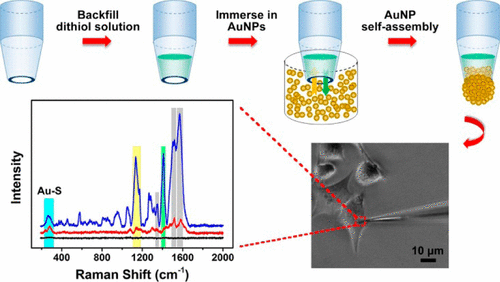当前位置:
X-MOL 学术
›
Anal. Chem.
›
论文详情
Our official English website, www.x-mol.net, welcomes your feedback! (Note: you will need to create a separate account there.)
Size-Controllable Gold Nanopores with High SERS Activity
Analytical Chemistry ( IF 7.4 ) Pub Date : 2017-09-11 00:00:00 , DOI: 10.1021/acs.analchem.7b02410 Hai-Ling Liu 1 , Jiao Cao 1 , Sumaira Hanif 1 , Chunge Yuan 1 , Jie Pang 1 , Rastislav Levicky 2 , Xing-Hua Xia 1 , Kang Wang 1
Analytical Chemistry ( IF 7.4 ) Pub Date : 2017-09-11 00:00:00 , DOI: 10.1021/acs.analchem.7b02410 Hai-Ling Liu 1 , Jiao Cao 1 , Sumaira Hanif 1 , Chunge Yuan 1 , Jie Pang 1 , Rastislav Levicky 2 , Xing-Hua Xia 1 , Kang Wang 1
Affiliation

|
Nanopore structures have been successfully employed in next-generation DNA sequencing. For more complicated protein which normally contains 20 different amino acids, identifying the fluctuation of ionic current caused by different amino acids appears inadequate for protein sequencing. Therefore, it is highly desirable to develop size-controllable nanopores with optical activity that can provide additional structural information. Herein, we discovered the novel nanopore properties of the self-assembled ultramicroelectrodes originally developed by Bard and co-workers. Using a slightly modified method, the self-assembly of 7 ± 1 nm gold nanoparticles (AuNPs) can be precisely controlled to form a gold nanoporous sphere (GPS) on the tip of a glass capillary. Different dithiol linker molecules (1,3-propanedithiol, C3; 1,6-hexanedithiol, C6; and 1,9-nonanedithiol, C9) reproducibly led to rather similar nanopore sizes (5.07 ± 0.02, 5.13 ± 0.02, and 5.25 ± 0.01 nm), respectively. The GPS nanostructures were found to exhibit high ionic current rectification as well as surface-enhanced Raman scattering (SERS) activity due to the presence of nanopores and numerous “hot spots” among the cross-linked AuNPs on the surface of GPS. The rectification effect of the small nanopores was observed even under high concentration of electrolyte (290 mM), along with SERS enhancement factors well above 1 × 105. The GPS nanostructures were successfully applied for SERS-based detection of glutathione from a single HeLa cell.
中文翻译:

具有高SERS活性的尺寸可控的金纳米孔
纳米孔结构已成功用于下一代DNA测序中。对于通常包含20个不同氨基酸的更复杂的蛋白质,识别由不同氨基酸引起的离子电流的波动似乎不足以进行蛋白质测序。因此,非常需要开发具有光学活性的尺寸可控的纳米孔,其可以提供额外的结构信息。在这里,我们发现了Bard及其同事最初开发的自组装超微电极的新型纳米孔特性。使用稍微修改的方法,可以精确控制7±1 nm金纳米粒子(AuNPs)的自组装,以在玻璃毛细管的尖端上形成金纳米多孔球(GPS)。不同的二硫醇接头分子(1,3-丙二酚,C3; 1,6-己二硫醇,C6 ; 和1,9-nonanedithiol,C9)分别可再现地产生相当相似的纳米孔尺寸(5.07±0.02、5.13±0.02和5.25±0.01 nm)。由于在GPS表面交联的AuNP之间存在纳米孔和大量“热点”,因此发现GPS纳米结构具有高离子电流整流能力以及表面增强拉曼散射(SERS)活性。即使在高浓度电解质(290 mM)以及SERS增强因子远高于1×10 5的情况下,也观察到了小纳米孔的整流作用。GPS纳米结构已成功应用于从单个HeLa细胞中基于SERS的谷胱甘肽检测。
更新日期:2017-09-11
中文翻译:

具有高SERS活性的尺寸可控的金纳米孔
纳米孔结构已成功用于下一代DNA测序中。对于通常包含20个不同氨基酸的更复杂的蛋白质,识别由不同氨基酸引起的离子电流的波动似乎不足以进行蛋白质测序。因此,非常需要开发具有光学活性的尺寸可控的纳米孔,其可以提供额外的结构信息。在这里,我们发现了Bard及其同事最初开发的自组装超微电极的新型纳米孔特性。使用稍微修改的方法,可以精确控制7±1 nm金纳米粒子(AuNPs)的自组装,以在玻璃毛细管的尖端上形成金纳米多孔球(GPS)。不同的二硫醇接头分子(1,3-丙二酚,C3; 1,6-己二硫醇,C6 ; 和1,9-nonanedithiol,C9)分别可再现地产生相当相似的纳米孔尺寸(5.07±0.02、5.13±0.02和5.25±0.01 nm)。由于在GPS表面交联的AuNP之间存在纳米孔和大量“热点”,因此发现GPS纳米结构具有高离子电流整流能力以及表面增强拉曼散射(SERS)活性。即使在高浓度电解质(290 mM)以及SERS增强因子远高于1×10 5的情况下,也观察到了小纳米孔的整流作用。GPS纳米结构已成功应用于从单个HeLa细胞中基于SERS的谷胱甘肽检测。



























 京公网安备 11010802027423号
京公网安备 11010802027423号